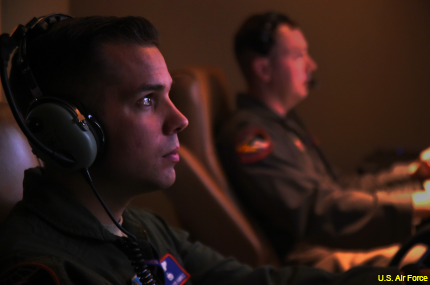Unmanned, manned systems work to get on the same page at Red Flag
The joint exercises in Nevada were designed to better integrate unmanned aerial capabilities into larger force operations.

An MQ-1B Predator sensor operator flies a unmanned sortie during Red Flag.
Red Flag is designed to provide a realistic battlefield environment in which crews can train together, in the process not only improving their own capabilities by becoming familiar with those of other units, an Air Force release stated.
A wide variety of aircraft from several service branches participated in the exercise, which is held four times annually and coordinated by Nellis Air Force Base at the Nevada Test and Training Range. Air Force aircraft included Predator UAVs, B-52 Stratofortresses, KC-135 Stratotankers, F-22 Raptors, F-16 Fighting Falcons, F-15 Eagles and F-15E Strike Eagles. The Navy’s EA-18G Growlers, F/A-18 Hornets and MH-60 Sikorsky and Marine Corps EA-6B Prowlers also took part.
This was not the first Red Flag in which unmanned aircraft took part, but there was a noticeable change in meeting goals for unmanned integration in larger force exercises, described as educating and familiarizing other major weapons systems communities with unmanned capabilities, the Air Force said. Units not associated with unmanned systems aren’t always aware of what they can do.
“There was definitely a learning curve in the beginning, but we really added value to the scenarios as the exercise progressed,” one participant said. “During the first week, we had to spend a lot of time carving out a role for ourselves, as the majority of the players were unfamiliar with what we could do and how we employ. As the exercise progressed, you would see the mission commanders start to utilize us in a larger role.”
Greater interoperability between manned and unmanned systems, along with more lethal aircraft, is the trajectory the Air Force appears to be going in. As operations shift from the uncluttered skies of the Middle East to more contested environments such as the Pacific, the Air Force is looking for ways to improve how aircraft can counter interference, jamming and other electronic warfare tactics, Defense One reported. One such improvement could be outfitting aircraft such as Reapers and Predators with radar receivers that will alert pilots when the aircraft has been detected by an adversary capable of denying it access.
According to the Air Force Strategic Master Plan, released in May, as the service moves “to the higher end of the spectrum of conflict, we will rely less on ISR data collected from airborne or space-borne capabilities that cannot operate in a contested environment.” The Air Force plans to address the challenge by enhancing standoff capabilities and investing in multi-domain, penetrating ISR capabilities; integrating sensors on all platforms; ensuring rapid and wide dissemination of processed ISR data; and prioritizing and pursuing attribution capabilities.
The Air Force Scientific Advisory Board will release its next study on enhancing unmanned systems in December 2016 and will:
- Identify potential future missions for UAVs in contested or denied environments, including ISR, strike, and other roles in integrated operations.
- Assess anticipated defensive characteristics across a range of potential future operating environments, from weakly contested airspace to anti-access/area-denial environments.
- Characterize expected survivability of current UAVs across these environments and compare to the performance of alternative approaches employing manned aircraft.
- Identify approaches other than signature reduction that may enhance the survivability of current and future UAVs across these environments and assess their relative efficacy.
- Assess the technologies needed to enable these approaches, identify current technology gaps, and assess the magnitude of the effort needed to fill those gaps.
- Make recommendations regarding the most valuable approaches for achieving enhanced utility of UAVs in contested and denied environments and across the range of potential future operating environments.




